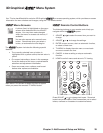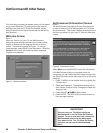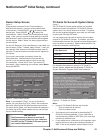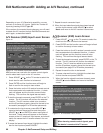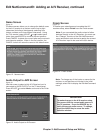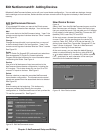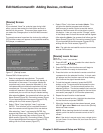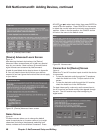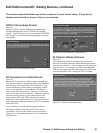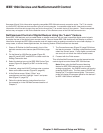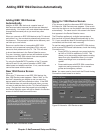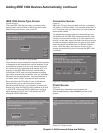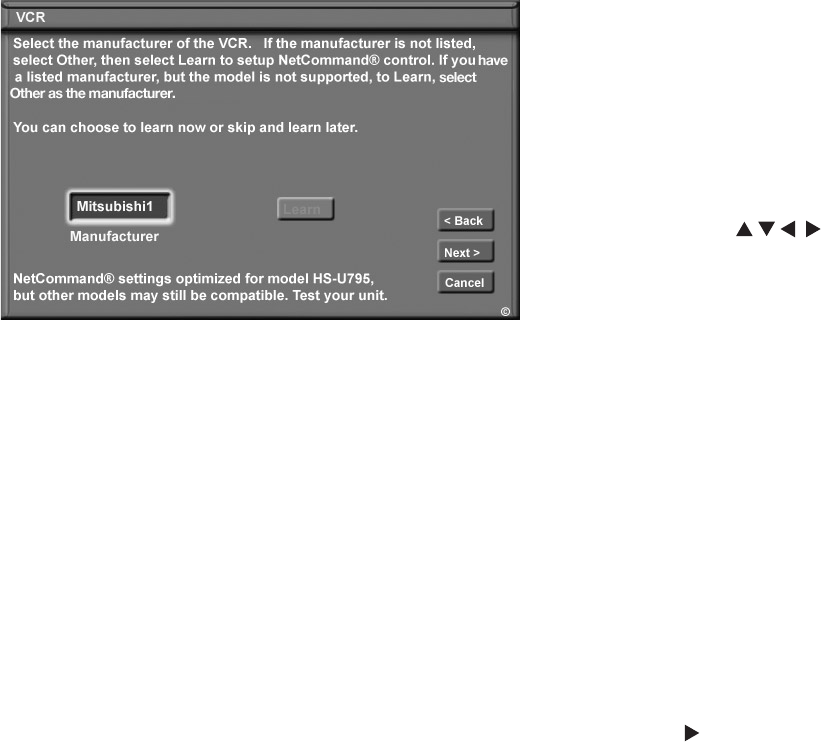
Chapter 3. NetCommand Setup and Editing 47
[Device] Screen
Figure 17
If you selected “None” for a device type during initial
setup, you can later select the Add option and add a
device with this screen. This screen also opens when
you select the Change option in the Edit NetCommand
screen.
The sample screens here show the choices for adding a
VCR; similar screens will appear for any satellite receiver,
DVD player, or cable box.
Figure 17. [Device] screen
Choose ONE of these options:
• Select a recognized manufacturer. The model
number optimized for NetCommand will display at
the bottom of the screen. If a number follows the
manufacturer’s name, (example: Mitsubishi 1), this
indicates additional models are optimized for that
manufacturer. For many device types, non-listed
models will operate in the same way as the listed
models and you can still use the pre-loaded setting.
After selecting Next>, the screens that follow are: the
Name Screen (Figure 20), Connection screen (Figure
21) and specialized device screens (Figures 22-24),
ending with the Finish screen (Figure 27).
• Select “Other,” then highlight “Learn” and press
ENTER. This will allow you to have NetCommand
learn the remote control signals of this new device.
After selecting “Learn” and pressing ENTER, the
screens that follow are: [Device] Learn screen (Figure
18), [Device] Advanced Learn screen (Figure 19),
Name screen (Figure 20), Connection screen, (Figure
21) and specialized device screens (Figures 22-24),
ending with the Finish screen (Figure 27).
Edit NetCommand®: Adding Devices, continued
• Select “Other,” skip Learn and select Next>. This
will allow the device to appear and will allow
NetCommand to switch inputs to use this device.
However, NetCommand will not be able to control
this device. Later you may use the “Change” option
in the Setup menu to learn the remote control signals.
After selecting Next>, the screens that follow are: the
Name Screen (Figure 20), Connection screen (Figure
21) and specialized device screens (Figures 22-24),
ending with the Finish screen (Figure 27).
Hint: The cable box and satellite receiver learn screens
include PVR functions.
[Device] Learn Screen
Figure 18
Shown only if “Learn” was selected
1. Press ADJUST to select the check box for
each function to be learned.
2. Press ENTER and the function name will begin to
flash to confirm the ready-to-learn status.
3. Press the button on the device’s remote control that
corresponds to the selected function. A check mark
will appear and the function name will stop flashing.
This confirms the signal learned status.
4. To test the learned command, press the ENTER
button on the TV remote while the learned function
is still highlighted. The device should perform the
selected function. The device needs to be turned on
and the IR emitters properly placed for the test to be
successful (see page 31 for IR emitter placement).
5. Repeat for each function to be learned.
6. To erase a learned function, highlight the check box
for that function and press CANCEL.
7. When the function signals have been learned, press
ADJUST to select Next> and move to the [Device]
Advanced Learn screen.
NOTE: When learning the device’s remote control
signals, point the device’s remote control at the TV
screen.
Hint: If the device’s remote control uses a single button
for both Power On and Power Off, don’t learn the Power
Off function.



